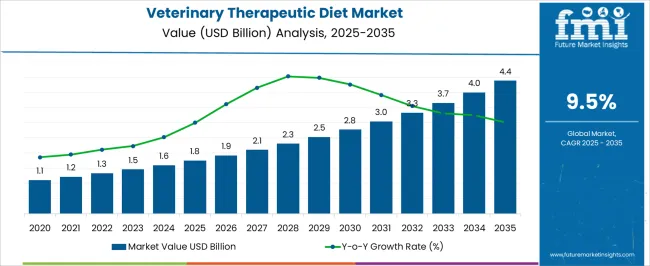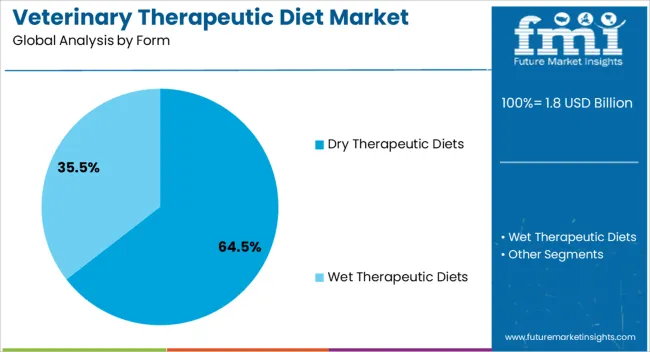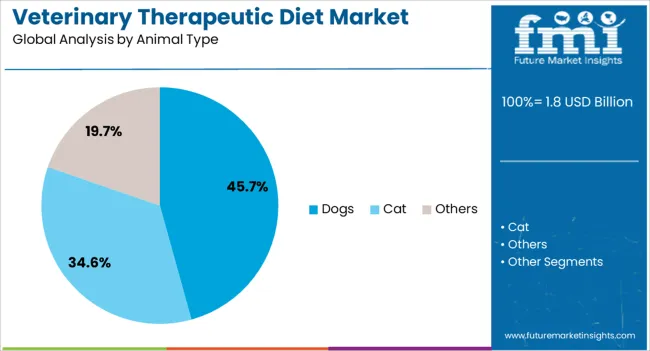The Veterinary Therapeutic Diet Market is estimated to be valued at USD 1.8 billion in 2025 and is projected to reach USD 4.4 billion by 2035, registering a compound annual growth rate (CAGR) of 9.5% over the forecast period.

| Metric | Value |
|---|---|
| Veterinary Therapeutic Diet Market Estimated Value in (2025 E) | USD 1.8 billion |
| Veterinary Therapeutic Diet Market Forecast Value in (2035 F) | USD 4.4 billion |
| Forecast CAGR (2025 to 2035) | 9.5% |
The veterinary therapeutic diet market is progressing at a healthy pace, driven by rising pet ownership, growing awareness of animal health, and the increased role of specialized nutrition in veterinary care. The market is shaped by a shift toward preventive healthcare for companion animals, with pet parents seeking diets that address chronic conditions such as obesity, renal issues, and allergies.
Expanding availability of therapeutic formulations across veterinary clinics and retail channels has supported adoption, while ongoing product innovation has widened options tailored to species-specific needs.
Increasing investments in animal healthcare infrastructure and the willingness of consumers to spend more on premium diets are contributing to positive long-term growth prospects.

The dry therapeutic diets segment leads the form category with approximately 64.5% share, reflecting its dominance in the global market. The segment benefits from ease of storage, cost-effectiveness, and longer shelf life compared to wet formulations.
Dry formats also allow precise nutrient balancing, ensuring consistent therapeutic effects in addressing chronic animal health conditions. The convenience of portion control and broad product availability through both retail and veterinary channels reinforce demand.
With increasing emphasis on targeted nutrition for pets, the dry therapeutic diets segment is expected to sustain its leadership over the forecast horizon.

The dogs segment represents approximately 45.7% share in the animal type category, underscoring the prominence of canine health management within the market. Rising incidences of obesity, joint issues, and gastrointestinal disorders in dogs have driven greater reliance on therapeutic diets.
Consumer willingness to adopt premium and veterinary-prescribed diets for dogs has reinforced segment growth. Furthermore, product innovation in flavor variety and condition-specific formulations has broadened market appeal.
With expanding pet populations and growing health awareness, the dogs segment is projected to retain its leading position in the forecast period.

The veterinary clinics segment holds approximately 47.8% share in the sales channel category, highlighting its status as the primary distribution hub for therapeutic diets. Clinics provide direct access to pet parents seeking professional guidance, thereby enhancing adoption of prescribed formulations.
Trust in veterinarians as key influencers in animal health decisions strengthens this channel’s relevance. Clinics also serve as educational touchpoints, enabling better compliance with prescribed nutrition regimens.
With growing pet healthcare expenditure and increased reliance on veterinary expertise, the clinics segment is expected to remain dominant in the distribution landscape.
Rising Pet Ownership Rates Globally Propelling Demand
In recent years, there has been a spike in pet adoption, especially across nations like the United States, and the trend is set to escalate further due to increasing number of pet enthusiasts. This, in turn, is anticipated to propel demand for veterinary therapeutic diets.
According to WorldAnimalFoundation.org, around 4.8 million dogs and cats are adopted annually in the United States. This spike in pet adoption will act as a catalyst fueling demand for pet therapeutic diets during the assessment period.
The more the pet adoption rate in a country, the more will be demand for pet food products, including therapeutic diets. Thus, companies will need to keep a close watch on pet adoption rates before entering a region or expanding their presence.
Growing Pet Humanization Trend Opening Growth Fortunes for Companies
Increasing interest in pet humanization and innovation in pet foods are key veterinary therapeutic diet sector’s latest trends. These factors can play a key role in dictating the growth of the veterinary therapeutic diet market.
Today, more and more pet owners are treating pets like family members. Modern consumers are willing to spend more money on the health and well-being of pets, creating scope for pet foods, including veterinary therapeutic diets.
As per the American Veterinary Medical Association (AVMA), around 85% of dog owners and 75% of cat owners consider their furry companions to be members of the family. The increasing sales of veterinary therapeutic diets, totaling USD 3.8 billion, speaks volumes about how much humans value pets.
High Cost of Veterinary Therapeutic Diets Limiting Sales
Veterinary therapeutic diets are generally more expensive than regular pet food as they contain specific nutrients and high-quality ingredients. This high cost is negatively impacting product demand.
To address this challenge, companies need to lower veterinary therapeutic diet prices. This will also make these specialized pet foods more accessible to a vast consumer base, especially across developing nations like India and China.
Global sales of veterinary therapeutic diets recorded a CAGR of 6.7% between 2020 and 2025. This growth was fueled by increased pet adoption and high spending on pet care products and services globally.
The outbreak of COVID-19 resulted in high cases of depression as people’s movement was limited. For instance, as per the COVID-19 Mental Disorder Collaborators, the pandemic led to a 27.6% increase in cases of chronic depressive disorders. This, in turn, positively improved pet adoption rate as well as demand for veterinary therapeutic foods.
Pet owners also spent huge amounts on specialized pet foods to tackle chronic diseases like allergies, diabetes, and digestive disorders among pets. This further boosted industry growth during the historical period.
Looking forward, the global veterinary therapeutic diet industry is projected to expand steadily between 2025 and 2035. This is attributable to thriving pet sector, growing interest in preventive pet healthcare, and increasing incidence of pet diseases.
Many pet organizations and government agencies are striving to enhance pet care by launching new policies and guidelines. For instance, the American Veterinary Medical Association (AVMA) and the American Animal Hospital Association (AAHA) collaboratively launched the inaugural Canine and Feline Preventive Healthcare Guidelines.
Manufacturers are striving to maintain transparency in ingredient sourcing. There is also a greater emphasis on research and development to create evidence-based formulas and improve the efficacy of therapeutic diets. Collaborations with nutritionists and veterinarians have increased in formulating diets that meet pets' nutritional requirements. These developments will play a key role in boosting the global industry during the next ten years.

The section below provides CAGRs of the pet therapeutic diet market across various countries. The United States, Japan, and the United Kingdom are set to experience higher CAGRs of 7.7%, 9.9%, and 8.7%, respectively through 2035.
The regional analysis of veterinary therapeutic diet market is also given to determine key pockets for companies closely. A combination of factors, including a thriving pet sector, favorable government support, and interest in preventive pet care, are behind this growth. Similarly, the impact of health and wellness on veterinary therapeutic diet sales in all these regions is given in the full report.
Growing adoption of pets, especially dogs and cats, is playing a key role in boosting growth of veterinary therapeutic diet market in Asia Pacific. Other veterinary therapeutic diet growth factors in emerging nations include rising emphasis on improving pet health and favorable government policies.
The United States veterinary therapeutic diet market is poised to register a CAGR of 7.7% during the assessment period. This is attributable to factors such as increasing pet ownership rates, escalating pet humanization trends, and innovation in pet food technology. The United States is witnessing increasing pet adoption and pet spending due to factors like a rapid economic boom and a high population of pet enthusiasts. This, in turn, will likely uplift veterinary therapeutic pet demand in the nation through 2035.
Around 70% of United States households own a pet, according to the American Pet Products Association. Similarly, about USD 1.6 billion was spent on pets in the United States in 2024. This is positively impacting veterinary therapeutic diet sales in the nation. The United States is also home to several leading pet food manufacturers. These companies keep investing in research and development activities to offer innovative products to consumers.
The regulatory environment also plays a key role in facilitating industry development in the United States. The nation has a well-defined regulatory framework that ensures quality standards and overall safety. Transparency and adherence to guidelines offer consumers self-belief in the quality of products available in the market.
China is anticipated to offer lucrative growth opportunities to manufacturers during the assessment period. The country will likely progress at a CAGR of 6.6% between 2025 and 2035, fueled by increasing pet ownership, growing awareness of pet health, and a spike in pet diseases.
In recent years, there has been a surge in chronic diseases like diabetes, allergies, and digestive disorders among pets in China. This has created a strong demand for veterinary therapeutic diets, and the trend is set to continue through 2035. Key manufacturers in the country are expanding existing businesses to cater to the growing demand from Chinese consumers. The focus is on introducing a variety of therapeutic diets tailored to address specific health concerns in pets, such as weight management and joint health.
China's sustained economic growth has empowered pet owners to invest in premium pet products, including pet therapeutic diets, to ensure the well-being of furry companions. This combination of increased pet ownership, strategic business expansion, and economic prosperity contributes to high sales in China.
Veterinarians in France play a crucial role in recommending therapeutic diets to address medical conditions in pets. The endorsement and guidance of veterinarians have significantly influenced pet owners' decisions to opt for veterinary therapeutic diets.
Continuous innovation and development of advanced formulations by key manufacturers have expanded the range of therapeutic diets available in the market. These specialized products cater to a wide array of health concerns, such as weight management, joint health, and digestive disorders, contributing to the increased sales of veterinary therapeutic diets in France.
The section below sheds some light on top segments and the anticipated growth rates. Companies can use this information to invest in popular diet types and forms to solidify their positions in the industry.
Based on animal type, the dog category is anticipated to hold a dominant position, accounting for a value share of 45.7% in 2025. In terms of diet type, the gastrointestinal health diets segment is projected to hold a share of 65.3% in 2025. On the other hand, the weight management diets category is set to witness high growth through 2035.
| Segment | Dog (Animal Type) |
|---|---|
| Value Share (2025) | 45.7% |
Dogs are prone to a wide range of health issues, such as obesity, joint problems, skin conditions, and allergies. To effectively manage these conditions, specialized diets are needed. This will continue to propel demand for veterinary therapeutic diets in dog category.
The strong emotional bond between dog owners and their pets often results in the shift toward best possible care, including nutrition. This is resulting in a higher demand for veterinary therapeutic diets tailored specifically for dogs. The target segment is set to hold a dominant market share of 45.7% in 2025.
| Segment | Gastrointestinal Health Diets (Diet Type) |
|---|---|
| Value Share (2025) | 65.3% |
When it comes to diet type, demand remains high for gastrointestinal health diets, and the trend is anticipated to persist in the coming years. The target segment will likely account for a value share of 65.3% in 2025, propelled by growing prevalence of digestive disorders and gastrointestinal infections in pets.
Gastrointestinal issues are commonly observed in pets, particularly in dogs and cats, making it a prevalent health concern among pet owners. The rise in digestive disorders, such as food sensitivities, irritable bowel syndrome, and gastrointestinal infections, is leading to a higher demand for specialized diets that can support digestive health and alleviate related symptoms.
Veterinary therapeutic diets formulated for gastrointestinal health often contain easily digestible ingredients like fiber to promote digestive function and overall well-being. Thus, increasing cases of digestive disorders in pets are set to directly impact gastrointestinal health diet sales.

New product development through continuous innovation is becoming a go-to strategy for leading manufacturers of veterinary therapeutic diets. Players are constantly focusing on creating specialized diets for different health concerns, including diabetes, allergies, and digestive issues.
Several companies are working on improving the palatability and nutritional value of products to ensure pets enjoy the food. Research and development have played a pivotal role in the success of veterinary therapeutic diets. Companies that continue to invest in research and development will have an edge in the future as well.
Many players emphasize product certifications and fulfill the increasing demand for natural and sustainable ingredients. Using online platforms like social media to expand customer base is gaining momentum. Similarly, strategies like partnerships, distribution agreements, collaborations, and acquisitions are becoming common in this growing sector.
Industry Updates
As per animal type, the market has been categorized into cats, dogs, and others.
Based on diet type, the report is segmented into weight management diets, diabetic management diets, gastrointestinal health diets, joint health diets, skin and coat health diets, dental health diets.
Different sales channels include veterinary clinics, pet specialty stores, online retailers, and others.
Based on form, the industry is bifurcated into dry therapeutic diets and wet therapeutic diets.
Industry analysis has been carried out in key countries of North America, Latin America, Europe, East Asia, South Asia, Oceania, and the Middle East and Africa.
The global veterinary therapeutic diet market is estimated to be valued at USD 1.8 billion in 2025.
The market size for the veterinary therapeutic diet market is projected to reach USD 4.4 billion by 2035.
The veterinary therapeutic diet market is expected to grow at a 9.5% CAGR between 2025 and 2035.
The key product types in veterinary therapeutic diet market are dry therapeutic diets and wet therapeutic diets.
In terms of animal type, dogs segment to command 45.7% share in the veterinary therapeutic diet market in 2025.






Full Research Suite comprises of:
Market outlook & trends analysis
Interviews & case studies
Strategic recommendations
Vendor profiles & capabilities analysis
5-year forecasts
8 regions and 60+ country-level data splits
Market segment data splits
12 months of continuous data updates
DELIVERED AS:
PDF EXCEL ONLINE
Veterinary Point of Care Diagnostics Market Size and Share Forecast Outlook 2025 to 2035
Veterinary Allergy Diagnostics Market Size and Share Forecast Outlook 2025 to 2035
Veterinary TSE Testing Market Size and Share Forecast Outlook 2025 to 2035
Veterinary Dermatology Market Forecast Outlook 2025 to 2035
Veterinary Telemedicine Market Size and Share Forecast Outlook 2025 to 2035
Veterinary Imaging Market Forecast and Outlook 2025 to 2035
Veterinary CRISPR-Based Detection Kits Market Size and Share Forecast Outlook 2025 to 2035
Veterinary Pregnancy Test Kit Market Forecast and Outlook 2025 to 2035
Veterinary X-Ray Illuminators Market Size and Share Forecast Outlook 2025 to 2035
Veterinary Scales Market Size and Share Forecast Outlook 2025 to 2035
Veterinary Grooming Aids Market Size and Share Forecast Outlook 2025 to 2035
Veterinary Micro-fibre Endoscope Market Size and Share Forecast Outlook 2025 to 2035
Veterinary Faecal Filters Market Size and Share Forecast Outlook 2025 to 2035
Veterinary Dental Equipment Market Size and Share Forecast Outlook 2025 to 2035
Veterinary Rapid Test Market Size and Share Forecast Outlook 2025 to 2035
Veterinary Glucometers Market Size and Share Forecast Outlook 2025 to 2035
Veterinary Pain Management Drugs Market Size and Share Forecast Outlook 2025 to 2035
Veterinary Anesthesia Machines Market Size and Share Forecast Outlook 2025 to 2035
Veterinary Thermography Market Size and Share Forecast Outlook 2025 to 2035
Veterinary Respiratory Disease Treatment Market Size and Share Forecast Outlook 2025 to 2035

Thank you!
You will receive an email from our Business Development Manager. Please be sure to check your SPAM/JUNK folder too.
Chat With
MaRIA